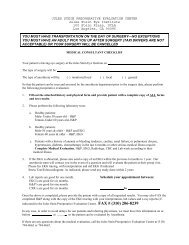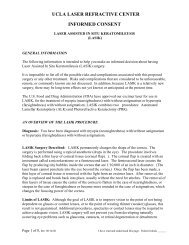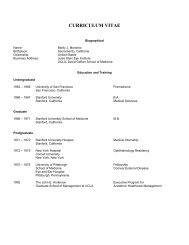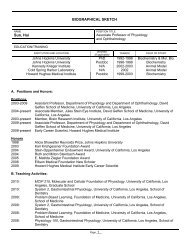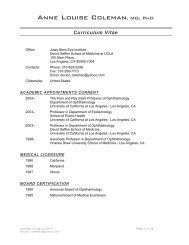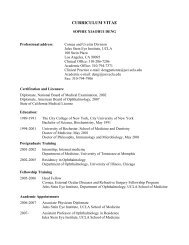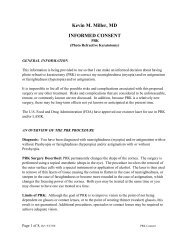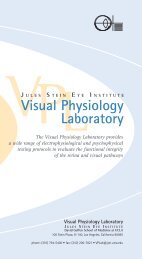View Annual Report - Jules Stein Eye Institute
View Annual Report - Jules Stein Eye Institute
View Annual Report - Jules Stein Eye Institute
Create successful ePaper yourself
Turn your PDF publications into a flip-book with our unique Google optimized e-Paper software.
Wayne L. hubbell, PhD<br />
<strong>Jules</strong> <strong>Stein</strong> Professor of Ophthalmology<br />
Distinguished Professor of Chemistry and Biochemistry<br />
Co-Chief of the Vision Science Division<br />
Associate Director of the <strong>Jules</strong> <strong>Stein</strong> <strong>Eye</strong> <strong>Institute</strong><br />
ReseaRch summaRy<br />
Molecular Basis of Phototransduction<br />
in the Vertebrate Retina<br />
Dr. Hubbell’s research is focused on understanding the<br />
complex relationship between molecular structure,<br />
plasticity, and conformational changes that control<br />
protein function in the visual system. Of particular<br />
interest are proteins that behave as “molecular switches,”<br />
that is proteins whose structures are switched to an<br />
active state by a physical or chemical signal. Examples<br />
include rhodopsin, the membrane-bound photoreceptor<br />
protein of the retina, and transducin and arrestin, pro-<br />
teins that associate with rhodopsin during function.<br />
The overall goal is to determine the structure of these<br />
proteins in their native environment, monitor the changes<br />
in structure that accompany the transition to an active<br />
state, and to understand the role of protein flexibility<br />
in function.<br />
To investigate these and other proteins, Dr. Hubbell’s<br />
laboratory has developed the technique of site-directed<br />
spin labeling, a novel and powerful approach to the<br />
exploration of protein structure and dynamics. By<br />
changing the genetic code, a specific attachment point<br />
in the protein is created for a nitroxide spin label probe.<br />
Analysis of the electron paramagnetic resonance (EPR)<br />
spectrum of the spin label provides information about<br />
the local environment in the protein. With a sufficiently<br />
large set of labeled proteins, global information on<br />
structure is obtained and changes in the structure<br />
during function can be followed in real time. While<br />
determination of static protein structure is important<br />
to understanding function, current research has highlighted<br />
a crucial role for protein flexibility (dynamics),<br />
which has not been previously appreciated. To explore<br />
molecular flexibility in proteins of the visual system,<br />
Dr. Hubbell’s group is developing novel methods using<br />
time-domain and high-pressure EPR.<br />
46 Faculty | Hubbell<br />
Public Service<br />
Member, National Academy of Sciences<br />
Member, American Academy of Arts and Sciences<br />
Honors<br />
Elected as a Fellow of the International Society of<br />
Magnetic Resonance in Medicine<br />
Research Grants<br />
National <strong>Eye</strong> <strong>Institute</strong>: Molecular Basis of<br />
Membrane Excitation, 5/1/05–4/30/13<br />
National <strong>Eye</strong> <strong>Institute</strong>: Core Grant for Vision Research<br />
at the <strong>Jules</strong> <strong>Stein</strong> <strong>Eye</strong> <strong>Institute</strong> (received an ARRA<br />
Administrative Supplement), 3/1/10–2/28/15



